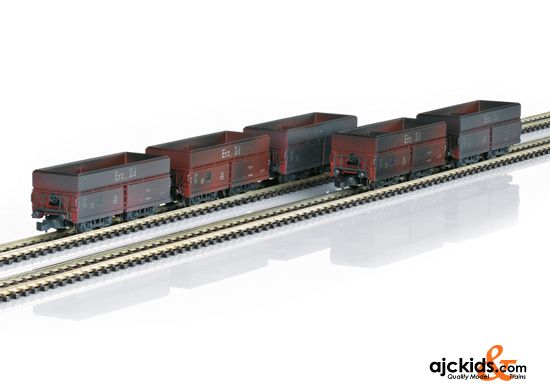Marklin 82801 - Ore Transport Freight Car Set.
Prototype: German Federal Railroad (DB) type OOtz 43 hopper cars, weathered.
Model: The type OOtz hopper car is new tooling. The car bodies are made of plastic, prototypically lettered and weathered. The cars have close coupler hooks.
Length over the buffers approximately 235 mm / 9-1/4".
Prototype information:
As in the past one of the most important raw materials today is steel with its special characteristics: In a heated state, it can be shaped almost any way desired by means of forging, rolling, pressing, and drawing. With certain alloys, it can be made very tough and tear resistant or elastic, harder or softer, non-rusting or high temperature resistant. There are more than 2,000 different types of steel. The basis of steel production is crude iron, which in turn is extracted from iron ore. Crude iron in large part consists of iron, other metals, and useless accompanying rock. The most important iron ore minerals are Magnetite, Hematite, and Siderite. The German iron and steel works are dependent mostly on the import of iron ore for the production of steel. The transport of this ore is done as far as possible in large quantities in one lot. In the Fifties, Emden with its bulk freight harbor was the pivot point or lynchpin for ore imports from Kiruna in Northern Sweden. This really became the case starting in October of 1963, when modern, more efficient transfer equipment for ore was put into service.
Initially 2,000 metric ton unit ore trains for the Ruhr area were the standard, but this changed with ore being supplied from Emden to the iron works on the Saar (switch from "native" ores to Sweden and overseas ores). With this additional traffic into Saarland, the German Federal Railroad thus changed to assembling two ore trains into a 4,000 metric ton set. These "ore bombers" were popular with railroad fans, and they were pulled by two class 043 steam locomotives between Emden and Rheine into the mid-Seventies. The share of overseas ore increased continuously with the ever-larger freight ships. These very large ore freighters could no longer use the Emden harbor due to their draft, and the ore import thus shifted increasingly to the Rotterdam harbor in the Eighties. It currently represents the central interface for the steel industry in Germany, Austria, and the Netherlands in the supply chain for iron ore, because almost 50% of the entire iron ore transfer in Northwest Europe is done in Rotterdam. The "highlight" on German rails are the heavy "ore bombers" of up to 6,000 metric tons that run on a regular four-hour schedule between Rotterdam and the Dillingen iron works. These trains are pulled by two class 151 or 189 electric locomotives.
EAN/UPC: 4001883828015



